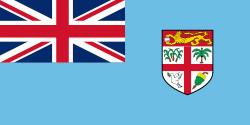Lautoka is the second largest city in Fiji. It is on the west coast of the island of Viti Levu, in the Ba Province of the Western Division. Lying in the heart of Fiji's sugar cane-growing region, the city has come to be known as the Sugar City. Covering an area of 32 square kilometres, it had a population of 71,573 at the 2017 census, the most recent to date.
Lautoka is known as the Sugar City because of its sugar cane belt areas. The main Lautoka Sugar Mill was founded in 1903, and is the city's biggest employer by far. Built for the Colonial Sugar Refining Company (Fiji) (CSR) by workers from India and the Solomon Islands between 1899 and 1903, it hires some 1,300 employees today. Other industries include timber milling, garment manufacturing, distillery, brewery, jewellery, blending, steelworks, fishing, hatchery, domestic items, paints, and construction.

















